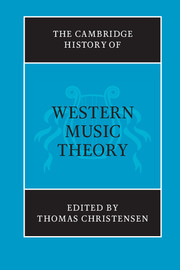Book contents
- Frontmatter
- Introduction
- PART I DISCIPLINING MUSIC THEORY
- PART II SPECULATIVE TRADITIONS
- PART III REGULATIVE TRADITIONS
- A Mapping tonal spaces
- 11 Notes, scales, and modes in the earlier Middle Ages
- 12 Renaissance modal theory: theoretical, compositional, and editorial perspectives
- 13 Tonal organization in seventeenth-century music theory
- 14 Dualist tonal space and transformation in nineteenth-century musical thought
- B Compositional Theory
- C Time
- D Tonality
- PART IV DESCRIPTIVE TRADITIONS
- Index of authors
- Index of subjects
- References
13 - Tonal organization in seventeenth-century music theory
from A - Mapping tonal spaces
Published online by Cambridge University Press: 28 March 2008
- Frontmatter
- Introduction
- PART I DISCIPLINING MUSIC THEORY
- PART II SPECULATIVE TRADITIONS
- PART III REGULATIVE TRADITIONS
- A Mapping tonal spaces
- 11 Notes, scales, and modes in the earlier Middle Ages
- 12 Renaissance modal theory: theoretical, compositional, and editorial perspectives
- 13 Tonal organization in seventeenth-century music theory
- 14 Dualist tonal space and transformation in nineteenth-century musical thought
- B Compositional Theory
- C Time
- D Tonality
- PART IV DESCRIPTIVE TRADITIONS
- Index of authors
- Index of subjects
- References
Summary
Otherwise known as the Age of Reason for the scientific undertakings and discoveries it witnessed, the seventeenth century is frequently seen as a period of uncertainty and confusion in the context of musical thought. From our own present perspective, musical thought of this period is overshadowed both by what precedes it and by what follows: the opposing poles of Renaissance modal theory and eighteenth-century harmonic tonality each seem more intelligible than that which we perceive as the transition between the two. Indeed, much of what we find in seventeenth-century theory appears to present a puzzling mix: ideas that accord strikingly well with the precepts of major-minor tonality appear to mingle freely with the teachings and terminology of modal theory. Added to this seeming paradox is the darkened mood of the theorists themselves, many of whom lament the confusion of their age.
And yet, seventeenth-century music treatises paint a clear, if richly detailed, picture of musical thought if we keep in mind that they address widely different purposes: to serve the church singer in a long-standing and relatively stable practice of liturgical chant; to train keyboardists and other chord-playing instrumentalists in the art of extemporizing harmonies over a bass; to educate the well-rounded musician in the established traditions of counterpoint and modal theory; to instruct the rational mind in the scientific bases of tuning systems; and finally, to enlighten the curious on more speculative and imaginative musical topics, such as Pythagoras’s fabled discovery of harmony in the sound of hammers at the forge, the Boethian harmonic strata, and the legendary origins of music itself.
- Type
- Chapter
- Information
- The Cambridge History of Western Music Theory , pp. 407 - 455Publisher: Cambridge University PressPrint publication year: 2002
References
- 18
- Cited by

